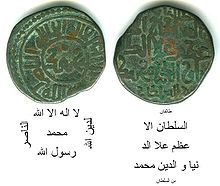Muhammad II (Khorezmia)
Ala ad-Din Muhammad II ( Persian علاءالدین محمد خوارزمشاه; with full name Ala ad-Dunya wa ad-Din Abul-Fath Muhammad Sanjar ibn Tekish , also Muhammad bin Tekeš; * 1169 ; † 1220 on the Caspian Sea ) belonged to the Anushteginid dynasty and was ruler of Khorezmia and large parts of Central Asia from 1200 as a Khorezm Shah .
The Mongols ended his rule in 1220.
Domination
Muhammad II was the son of Ala ad-Din Tekish and Terken Chatun. He inherited his father in 1200; Immediately after his accession to the throne, Muhammad II had to fend off an invasion of the Ghurids under the brothers Ghiyas ad-Din Ghori and Mu'izz ad-Din . They penetrated Khorasan , conquered Nishapur and advanced in the direction of Rey , but only got as far as Gorgan . When Ghiyas died in Herat in 1202, Muhammad II took this opportunity and besieged Herat himself. However, Mu'izz ad-Din was able to beat him before Herat, so that now Muhammad II, fleeing from Mu'izz ad-Din, withdrew to his capital, Gurganj . Mu'izz ad-Din in turn besieged Gurganj and Muhammad II turned in desperation to the Kara Kitai , who sent an army. Mu'izz ad-Din had to withdraw. Mu'izz ad-Din was later murdered in 1206.
Muhammad II was later called upon by Mu'izz ad-Din's successor, Ghiyath ad-Din Mahmud, to help against an insurgent general. Instead of attacking this general in Ghazni, Muhammad II turned against Ghiyath ad-Din Mahmud and captured Balch and Termiz . But during his campaign of conquest, Muhammad II was captured by the Kara Kitai and was only released 13 months later. Once again in freedom, Muhammad II conquered Herat and forced Ghiyath ad-Din Mahmud under his suzerainty.
Muhammad II did not stop and conquered other cities and areas. He took Samarkand in 1207 and wrested from the Bawandids Tabaristan and the Karakhanids Transoxania in 1210 . His expansionist policy made him ruler over Tashkent , Fargʻona , Makran and Balochistan . In 1211, the Atabegs of Azerbaijan became his vassals.
In 1212 he destroyed the western part of the Qarakhanids by executing their last ruler Ulugh-Sultan Uthman, and in 1215 the last remains of the Ghurids fell to him. In 1212 the people of Samarkand rebelled against his rule, killing 8,000 to 10,000 Khorezmians. Muhammad II burned the city in retaliation and executed 10,000 residents.
By 1217 he had conquered the whole country between Syr Darya and the Persian Gulf and had made himself Shah . Muhammad II wanted to legitimize his power through the caliph in Baghdad . But when the caliph an-Nāsir li-Dīn Allaah refused, Muhammad II gathered an army and marched on Baghdad. But when he crossed the Zāgros Mountains , Muhammad II lost thousands of soldiers in a snow storm. He had no choice but to turn around.
Decline and death
In the east, a great empire arose with the Mongols, which bordered on Muhammad's empire after the victory against the Kara Kitai. In 1218 there was first contact between the two powers when Mongols crossed the border in pursuit of an enemy general. Genghis Khan - busy with the conquest of China - sent a delegation to Khorezmia to establish trade relations. But Muhammad II, startled by the reports of the Mongol atrocities, saw the embassy as a ruse against his country. So the embassy was accused of espionage by the Choresm governor of Otrar and arrested. Genghis Khan then sent three ambassadors, two Mongols and a Muslim, to the Shah to give him another chance and to hand over the governor Inalchik . But Muhammad II not only had the ambassadors executed, but also the entire first embassy, which, according to some opinions, comprised a hundred to 450 men. Genghis Khan's revenge was going to be cruel, even by Mongolian standards. In 1219 he marched into Khorezmia with over 100,000 men and completely destroyed the cities of Samarkand and Bukhara . All the cities of the empire fell victim to it, and countless historical artifacts and records were destroyed.
The Shah himself fled from the Mongols and died of pleurisy in 1220 on an island in the Caspian Sea near the port of Abaskun. His eldest son Jalal ad-Din later tried to recapture the empire, but failed and died in 1231 as the last Khorezm Shah.
swell
- CE Bosworth : The Cambridge History of Iran, Volume 5: The Saljuq and Mongol periods . Ed .: RN Frye. Cambridge University Press, Cambridge 1968, ISBN 0-521-06936-X , The Political and Dynastic History of the Iranian World (AD 1000-1217), pp. 1–202 ( limited preview in Google Book search).
- Neil Blandford, Bruce Jones: The World's Most Evil Men . 1985.
- Nigel Cawthorne: The World's Worst Atrocities . 1999.
- John Man: Genghis Kahn - Life, Death and Resurrection . 2004.
- Jürgen Paul : Central Asia. S. Fischer, Frankfurt am Main 2012 ( New Fischer World History , Volume 10)
Individual evidence
- ^ Jürgen Paul: Central Asia. 2012, p. 289
- ↑ Michel Biran, The Empire of the Qara Khitai in Eurasian History , (Cambridge University Press, 2005), 70.
- ↑ Rafis Abazov, Palgrave Concise Historical Atlas of Central Asia , (Palgrave Macmillan, 2008), 43rd
- ↑ Rafis Abazov, Palgrave Concise Historical Atlas of Central Asia , 43rd
| personal data | |
|---|---|
| SURNAME | Muhammad ii |
| ALTERNATIVE NAMES | Ala ad-Din Muhammad II (full name); Ala ad-Dunya wa ad-Din Abul-Fath Muhammad Sanjar ibn Tekish; علاءالدین محمد خوارزمشاه (Persian) |
| BRIEF DESCRIPTION | Ruler of the Khorezm Shahs |
| DATE OF BIRTH | 1169 |
| DATE OF DEATH | 1220 |
| Place of death | Caspian Sea near Abaskun |


